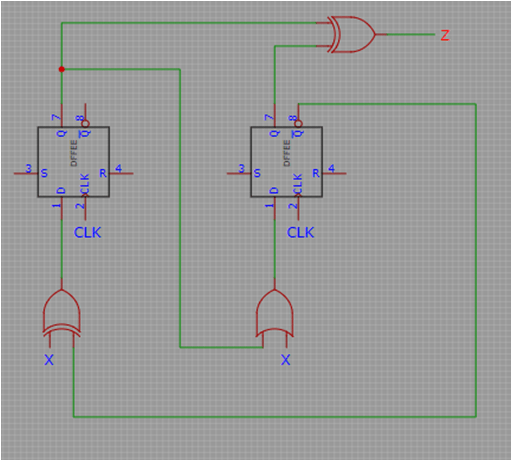This set of Logic Design Multiple Choice Questions & Answers (MCQs) focuses on “Clocked Sequential Circuits – Analysis by Signal Tracing and Timing Charts”.
1. The output of which type of clocked sequential circuits depends only on the present states of the used flip-flops?
a) Mealy Circuits
b) Moore Circuits
c) Sequential Circuits
d) Logic Circuits
View Answer
Explanation: Moore circuit is the type of clocked sequential circuits where the output depends only on the present state of the used flip-flops. It is named after the inventor Edward Moore. In Mealy circuit, the output depends both on the input and the present states of the flip-flops. In sequential circuits, the output depends on both the inputs and the present states based on the circuitry. In logic circuits flip-flops are not used.
2. The output of which type of clocked sequential circuits depends on the present states of the used flip-flops as well as on the circuit inputs?
a) Mealy Circuits
b) Moore Circuits
c) Sequential Circuits
d) Logic Circuits
View Answer
Explanation: Mealy circuit is the type of clocked sequential circuits where the output depends on the present states of the used flip-flops as well as the circuit inputs. It is named after the inventor George H. Mealy.
3. Moore Machine is an application of which of the following?
a) Finite Automata with no input
b) Finite automata with output
c) Non-finite automata with an output
d) Non-finite automata without an output
View Answer
Explanation: Finite automation with an output is classified in two groups: Moore and Mealy Machine. Thus, Moore machine performs finite automation with output. Hence the right answer is finite automata with output.
4. What are the elements included in state chart diagrams?
a) Transitions
b) Condition markers
c) Iteration markers
d) Lifeline markers
View Answer
Explanation: Transitions between different states are shown through the elements of a state table. The other options like condition markers, iteration markers and lifeline markers are not related to state chart diagrams.
5. Which of the following represents the output of a Moore Machine?
a) Op(t) = D(Op(t))
b) Op(t) = D(Op(t)i(t))
c) Op(t) = c
d) Op(t) = D(Op(t)/i[t])
View Answer
Explanation: The output of a Moore machine depends only on the present state of the flip-flops, not on the inputs. Thus D(Op(t)) only fulfils the criteria. This is the defined definition of how the output is received on giving a specific input to a Moore machine. The option Op(t) = D(Op(t)i(t)) defines the dependence of output on input that is the characteristic of a Mealy machine. And Op(t) = c defines a constant output that is impossible. Op(t) = D(cOp(t)) is also shows dependence on input. Hence Op(t) = D(Op(t)) is the right answer.
6. Which type of clocked sequential circuit is shown in the following diagram?

a) Mealy Machine
b) Moore Machine
c) Full Adder
d) Half Adder
View Answer
Explanation: It is clear from the diagram that the output Z is not related to any input given to the circuit. But the output only depends on the outputs of the flip-flops or more precisely the present states of the flip-flops. The sole dependency on the present state of used flip-flops indicate the behavior of Moore machine.
7. In a state table, when do the two states are termed as equivalent?
a) Both have same output only
b) Both have same next state only
c) Both have same output as well as same next state
d) Both have same input
View Answer
Explanation: States are represented as rows in a state table. Two states in a state table are termed equivalent if and only if the next states as well as the outputs of both states are same.
8. Which Circuit model of the following is termed as class A circuit model?
a) Moore Circuit with output decoder
b) Moore Circuit without output decoder
c) Mealy Circuit
d) Memory Circuits only
View Answer
Explanation: In class A circuits, the output depends on the present states of used flip-flops as well as the circuit inputs. This is the main characteristics of the Mealy circuits. Hence the correct answer is Mealy Circuit. Notably no output decoder is used in class A circuits.
9. Which Circuit model of the following is termed as class C circuit model?
a) Moore Circuit with output decoder
b) Moore Circuit without output decoder
c) Mealy Circuit
d) Memory Circuits only
View Answer
Explanation: Moore circuits with decoders are termed as class B circuits where the output depends only on the present states of the flip-flops. Mealy circuits are of class A as the output depends both on the input and the present state of the used flip-flops. Again, memory circuits are termed as class E circuits. Hence the correct answer is Moore circuit without output decoder as the remaining options are not correct.
10. In the timing diagram of sequential synchronous circuits, what the false outputs are termed as?
a) Spikes
b) Delays
c) Distortions
d) Jerks
View Answer
Explanation: Two types of false outputs can occur. In one case the output momentarily goes to 0 and returns to 1 before the active clock edge. In the other case the output momentarily goes to 1 and returns to 0 before the active edge. These false outputs are often referred to as spikes.
Sanfoundry Global Education & Learning Series – Logic Design.
To practice all areas of Logic Design, here is complete set of 1000+ Multiple Choice Questions and Answers.
If you find a mistake in question / option / answer, kindly take a screenshot and email to [email protected]
